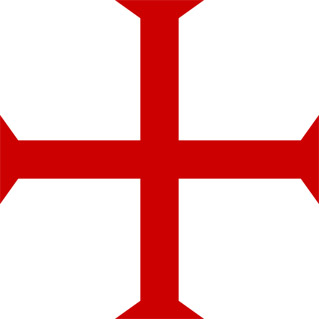Difference between revisions of "Templar Mysteries"
| Line 41: | Line 41: | ||
===Higher Mysteries=== | ===Higher Mysteries=== | ||
* '''X (•••):''' X | * '''X (•••):''' X | ||
| − | * ''' | + | * '''Mingling of God's Light (••••):''' The Templar may cast two or more spells from the Prime and Spirit Arcana as combined spells at one point of Gnosis lower than normal for doing so. Additionally, the Templar does not have to increase the effective rating of the Arcana involved in the casting by +1 - he may simply perform it at the normal levels to cast those effects separately. |
* '''X (•••••):''' X | * '''X (•••••):''' X | ||
Revision as of 23:10, 17 July 2007

|
The Poor Fellow-Soldiers of Christ and of the Temple of Solomon (Latin: Pauperes commilitones Christi Templique Solomonici), popularly known as the Knights Templar or the Order of the Temple, were among the most famous of the Christian military orders. The organization, which existed for approximately two centuries in the Middle Ages, was created in the aftermath of the First Crusade of 1096 to ensure the safety of the large numbers of European pilgrims who flowed toward Jerusalem after its conquest.
Officially endorsed by the church in 1129, the Order became a favored charity across Europe and grew rapidly in membership and power. Templar knights, easily recognisable in their white mantle with a distinct red cross, made some of the best equipped, trained, and disciplined fighting units of the Crusades. Non-warrior members of the Order managed a large economic infrastructure throughout Christendom, innovating many financial techniques that were an early form of banking, and building numerous fortifications across Europe and the Holy Land.
The Templars' success was tied closely to the success of the Crusades. When the Holy Land was lost and the Templars suffered crushing defeats, support for the Order's existence faded. Rumors about the Templars' secret initiation ceremony created mistrust, and King Philip IV of France, deeply in debt to the Order, began pressuring Pope Clement V to take action. On Friday, October 13, 1307, King Philip had many of the Order's members in France arrested, tortured into "confessions", and burned at the stake. In 1312, Pope Clement, under continuing pressure from King Philip, forcibly disbanded the entire Order. The sudden disappearance of a major part of the European infrastructure gave rise to speculation and legends, which have kept the name "Templar" alive in modern fiction.
One of the central accusations levied against the Knights Templar was the worship of a demonic entity called "Baphomet," depicted as a breasted hermaphroditic goat-creature in roughly humanoid shape, with a torch set between its horns and a pentagram upon its forehead. With two fingers it gestures above it, and with the two fingers of its other hand, it gestures below it (a gesture recognizable in the Magus of the Tarot as well). A set of great black wings rises from its back, and rather than genitals, a caduceus rises from its lap. Tattooed to one arm is the world SOLVE (Dissolve) and "COAGULA" (Congeal) is writ upon the other.
In truth, the first Knights Templar discovered a rare thing while in the Holy Land: the Awakening. Understanding the need to hide what they'd found, they constructed the Baphomet figure as a symbol that might be used to explain Atlantean Mysteries to those who came closer to Awakening, possibly spurring them into an Awakening for the glory of God. The tower-like torch, burning with the Supernal Flame rises above the animalistic head, representing the earth-bound intelligence, symbolizing the Watchtower at which the initiate signs his name (symbolized by the pentagram, which also suggests five Towers). The gesture of the Baphomet is an ancient Atlantean mudra, meaning "As Above, So Below," and symbolizing the act of drawing power down a Watchtower. The merging of opposites - male/female, beast/animal, Heaven/earth, sky/ground, dissolution/congealing - represents the goal of the Knights, which was unity with the glory of God by those who are unworthy and mortal.
Even its name is an atbash cypher; when the name is rendered in Hebrew, and the cipher applied (wherein a letter is exchanged with its opposite from the other end of the alphabet, so that the first letter from the right is exchanged with the first letter from the left, the second from the right is exchanged with the second from the left, etc.), it spells out the true name of the entity: the Hebrew name for "Wisdom."
Templar magic is based solidly around the concept of being one of God's warriors - of being the channel by which the Holy Light is brought to Earth. Because Templars originated the concept of banking in Western Europe, many Templars are quite wealthy and involved in the financial world, and among the nobility of Europe. It is almost unheard of for a woman to be Knighted by another Knight, but there are a rare few Dames of the Knights Templar, who are every bit as potent in battle as their male counterparts.
Prerequisites
Tradition Skills
- X:
- X:
- X:
- X:
- X:
Praxis
- X:
- X:
- X:
- X:
- X:
Correspondences
- X:
- X:
- X:
- X:
- X:
Higher Mysteries
- X (•••): X
- Mingling of God's Light (••••): The Templar may cast two or more spells from the Prime and Spirit Arcana as combined spells at one point of Gnosis lower than normal for doing so. Additionally, the Templar does not have to increase the effective rating of the Arcana involved in the casting by +1 - he may simply perform it at the normal levels to cast those effects separately.
- X (•••••): X